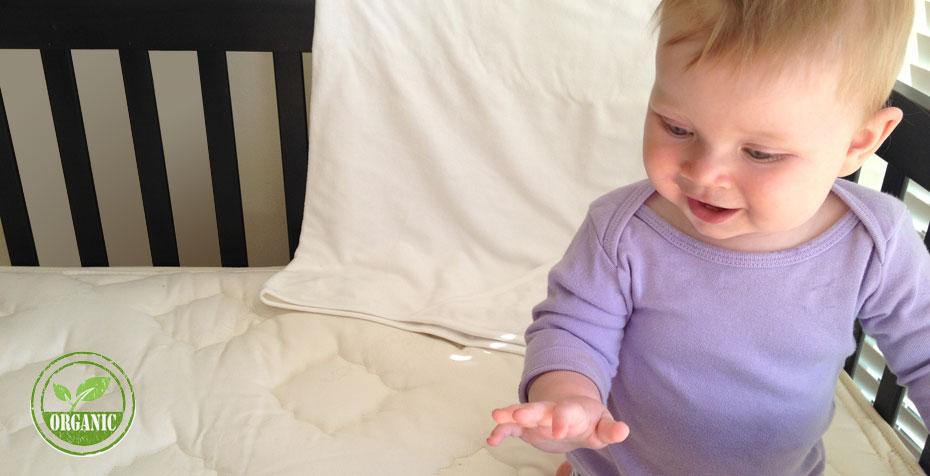No products in the cart.
Blog, Latex Mattresses
Conventional Crib Mattress vs. Organic Latex Mattress
Conventional Crib Mattress vs. Organic Latex Mattress
Fact: Conventional crib mattresses can contain a toxic mix of chemicals as well as synthetic unnatural fibers like polyester(plastic).
Here at Sleeping Organic, we manufacture and provide organic latex mattresses, organic latex toppers and latex pillows. We made organic latex crib mattresses for years and wanted to create a short post to give a little insight and our crib mattress recommendations.
Conventional Crib Mattresses
Parents everywhere go to great lengths to buy safe strollers, car seats, cribs and clothing to protect their babies but seldom consider the dangers associated with exposing their infant to toxic chemicals commonly found in crib mattresses.
Most conventional crib mattresses are waterproofed with PVC (Polyvinyl Chloride), which is considered to be the most toxic of all plastics by the FDA and the Consumer Product Safety Commission. Phthalates, which make up roughly 30% of PVC, are toxins which are not bound to the plastic and consequently leech out from it. DEHP is the most common phthalate used in baby mattresses. Phthalates have already been banned across Europe in many other consumer products. The PVC surfaces of conventional baby mattresses are also treated with toxic fire-retardant chemicals.
Recent studies have also found that xenoestrogens are found to be abundant in plastics. These plastics are found everywhere these days. Clothing, food packaging, water bottles and more. These xenoestrogens are known endocrine and hormonal blockers and disrupters. By choosing plastic alternatives for everyday items, you can decrease your child and yourself to this exposure.
Conventional mattress sources use chemical additives that include formaldehyde and other known toxic chemicals such as Organotin compounds. Another predominant material found in baby and adult mattresses is Polyurethane foam.
Because Polyurethane foam is extremely flammable, conventional mattresses must be treated with a fire retardant such as pentaBDE, a toxin associated with hyperactivity and neuro-behavioral alterations. PentaBDE, much like Phthalates, is not bound to the foam, and leaches out into the air (also known as off-gassing). PentaBDE has recently been banned by the state of California and in Europe.
These chemicals are neurotoxins, yet they are used in so many products we depend on daily. Children are far more vulnerable to toxic chemicals than adults are, especially in the first few years of brain development and physical growth. Studies show there is a strong correlation between these neuro-toxic chemicals and the causes of a host of illnesses including ADHD, Childhood Wheeze, Asthma and even sudden infant death syndrome (SIDs).
Considering infants and toddlers spend so much of their time nestled in bed at night and at naptime, choosing a crib mattress that does not contain harmful chemicals is one of the wisest choices parents can make to protect their children.
Why Choose an Organic Crib Mattress over a Conventional Crib Mattress?
- Formaldehyde
- Polyvinyl Chloride
- Organotin Compounds
- PentaBDE
- Phthalates
- Synthetic Fire Retardants
- Polyurethane Foam
- DEHP
Benefits of an Organic Latex Mattress for Cribs
1. Free of Harsh Chemicals and No Fire-Retardant Chemicals
Organic latex crib mattresses should only contain 3 ingredients. Organic cotton, wool and latex. With all of these organically raised and sourced material you can provide the optimal sleeping surface for your little one.
You will also be fine with using an innerspring unit that is covered with for organic cotton and wool. These are our second recommendation as you can’t see what’s inside of the innerspring mattress where on a latex crib mattress the cover usually has a zip off cover.
Both of these options will or should use a tight wool weave as the fire barrier which naturally replaces any flame or fire retardant.
2. Ideal Sleeping Surface
Going with an organic latex mattress will provide a great flat supportive sleeping surface for the child. Usually, the latex crib mattresses are 6 inches thick made with 2 layers of 3-inch latex. A nice Dunlop configuration with a medium layer with firm underneath would be the softest recommended layer configuration.
Always choose Dunlop latex for crib mattresses as you can choose GOLS certified organic Dunlop for utmost purity. Talalay is too soft and isn’t certified organic even though it is 100% natural Talalay we still recommend going with the Dunlop for crib mattresses.
3. Organic Latex Mattress Certifications for Crib Mattresses
When shopping for an organic latex crib mattress look for GOLS, GOTS, and Oke-Tek certifications on the components of the crib mattress. If the crib mattress itself is certified organic by GOTS that is the best. There are other certifications serve as marketing fodder, but these are the best.
The Best Organic Latex Crib Mattress – The Best Crib Mattress
We don’t manufacture organic latex crib mattresses anymore, but we did for many years. Who knows, maybe we will bring them back one day. However, we do have a couple suggestions.
We really like the organic cotton, wool and latex crib mattress from Avocado. It doesn’t have any coating sprayed on the crib cover. We recommend avoiding any waterproofing in the form of coatings or crib coverings derived plastic materials even if it’s “food grade”. If you want to protect the crib mattress from bodily fluids, we recommend a wool cover like the puddle pad from Holy Lamb Organics.
We hope this article helps in pointing you towards a healthier sleeping environment.
If you’re just discovering the world of organic and 100% natural latex. Here’s a video of a great introductory product.
